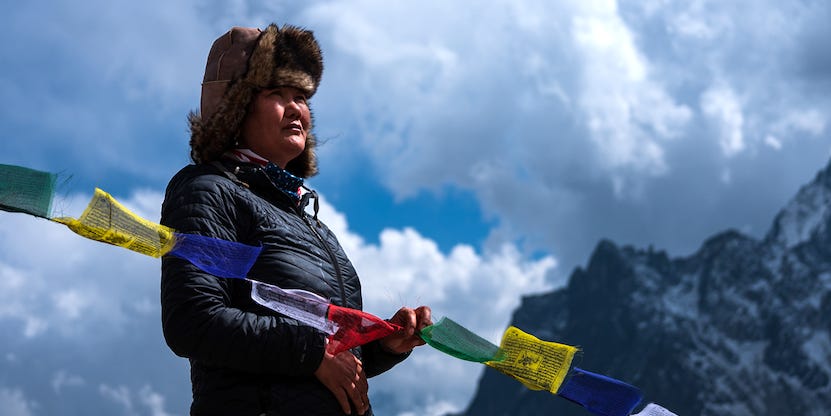Lhakpa Sherpa was smiling. But inside, she was a bundle of nerves.
On July 30, the single mom of three was hours away from seeing the most triumphant and painful moments of her life become irreversibly public.
The 50-year-old is the subject of a Netflix documentary, “Mountain Queen: The Summits of Lhakpa Sherpa,” out July 31. Directed by Lucy Walker, the film traces Sherpa’s journey to summit Mount Everest a record-setting 10 times.
Sherpa said in the film that she isn’t humble — but the woman who insisted to Business Insider via video call that she isn’t a “queen” like the movie’s title suggests seems to be the very definition of the word.
Now based in West Hartford, Connecticut, with her two daughters, Sherpa has lived a double life of sorts since she moved to the US at 28.
Whenever she could go back to Nepal, she guided expeditions alongside her brother and then-husband.
But it wasn’t enough to make ends meet. As a Nepalese citizen, Sherpa has to pay only a fraction of the $11,000 foreigners are required to spend on Everest climbing permits.
Even though she thinks mountain guides are compensated fairly, Sherpa said that income had never been enough to sustain her and her kids. She always had additional jobs, like working at Whole Foods.
All along, the documentary reveals, she was battling abuse by her ex-husband.
These days, Sherpa told BI, she cleans houses for “rich people,” some of whom may only now realize what the woman mopping their floors is capable of.
But Sherpa said she doesn’t mind when people don’t recognize her for her climbing feats. She didn’t summit Everest for fame, but to challenge herself and others not to give up.
“Follow the dream,” she said. “You can reach your mountain.”
Sherpa defied the odds to climb Everest 10 times
Sherpa was born in a Nepalese village in the 1970s, when the idea of a woman climbing Everest was unheard of. (Most Sherpas have the last name Sherpa.)
She got her first mountaineering job — as a porter carrying hundreds of pounds of climbing equipment to base camp — because she chopped off her hair and pretended to be a boy.
Her family didn’t approve, but Sherpa fell in love with the mountain.
She worked her way up through different climbing support jobs, even spending time as a “kitchen boy,” making meals for climbers and guides.
The opportunity to make it to the top of Mount Everest only came years later, after she happened to meet Nepal’s prime minister in a chance encounter.
When Sherpa told him she wanted to summit the mountain to prove that women can do it and survive, he tasked her with leading an all-woman Nepalese expedition in 2000.
Sherpa was the only member of the group to successfully reach Everest’s summit, and she returned as a national hero.
Everest was her refuge from a turbulent marriage
The Himalayan Database reported that Mount Everest has claimed the lives of more than 330 people since the early 1900s. But the deadly dangers have never terrified Sherpa.
“I know this mountain very well,” she said, likening it to her childhood “best friend.”
As the documentary shows, the real tragedies in Sherpa’s life took place at the hands of her ex-husband, George Dijmarescu.
Sherpa and Dijmarescu, who was also a climber, met in Kathmandu in 2000. When the relationship became romantic, she moved to Connecticut, where they married and had daughters Sunny, now 22, and Shiny, 17.
In the film, Sherpa said Dijmarescu became physically aggressive during their marriage, making her feel like a “house sherpa” who only cooked, cleaned, and looked after the kids.
After a particularly violent episode in 2011, when Dijmarescu beat Sherpa to the point she needed to be taken to the hospital, she gathered the courage to leave him for good.
She gained sole custody of her children, and they spent eight months together at a shelter before eventually relocating to West Hartford.
Dijmarescu died from cancer in 2020.
Reflecting on the decision to leave Dijmarescu in the film, Sherpa said she didn’t “want to die at this man’s hand.”
“I want to die with peace in the mountain,” she said.
Sherpa kept chasing mountain-climbing dreams
After her 10th Everest summit in 2022, Sherpa secured funding to climb K2, a longtime goal of hers.
Despite being 800 feet shorter, “The Savage Mountain” in Pakistan is considered even deadlier than Everest because of its steepness.
Even though she’d conquered Everest, Sherpa tells BI that she only felt like a professional mountain climber after tackling K2.
To her, it’s proof to any naysayers that women can “climb any kind of mountain,” no matter how “technical.”
A year later, Sherpa’s goals have changed again.
While she isn’t ruling out returning to Everest — perhaps accompanied by her daughters — she’s keen to explore mountains within the US.
She dreams of being a full-time climbing guide and working with kids, who she believes would benefit from less time on their phones and more time outdoors.
But doing that, on top of rent and saving to put her girls through college, requires money.
The documentary about her on the world’s largest streaming platform will, Sherpa thinks, help with that part.
Just as she’s helped people avoid death on Everest, Sherpa said, she hopes her story will reach people who might be able to assist during her own time of need.
Read the full article here


